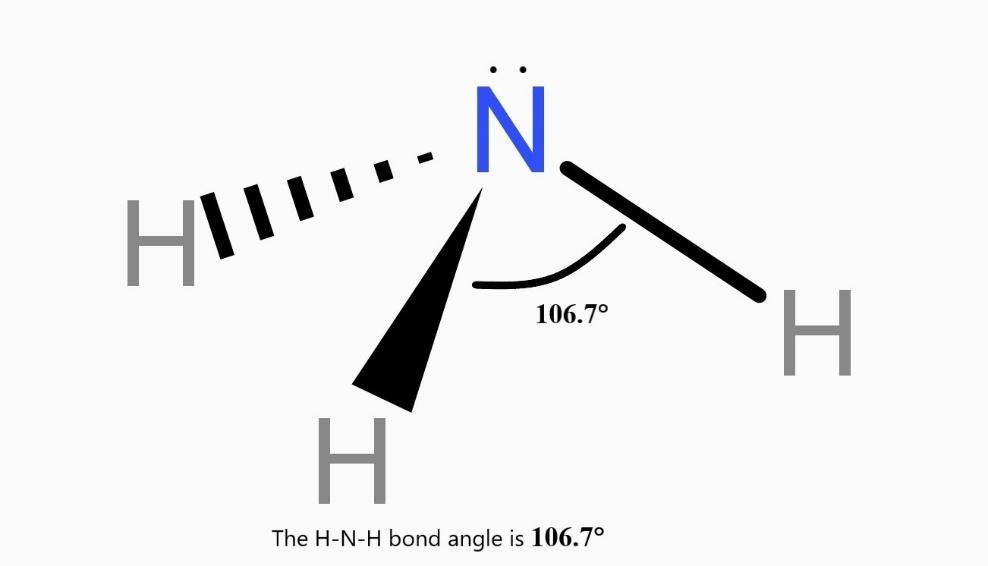
Draw the structure diagram of ammonia molecule as per the valence-shell electron pair repulsion theory.
Answer
492.9k+ views
Hint: Valence shell electron pair repulsion theory, or VSEPR theory, is a concept used in chemistry to determine the structure of single molecules from the number of pairs of electrons surrounding their central atoms. The formula of an ammonia molecule is $N{{H}_{3}}$.
Complete answer:
Valence-shell electron pair repulsion theory: The Valence Shell Electron Pair Repulsion Theory abbreviated as VSEPR theory is based on the premise that there is a repulsion between the pairs of valence electrons in all atoms, and the atoms will always tend to arrange themselves in a manner in which this electron pair repulsion is minimalized. This arrangement of the atom determines the geometry of the resulting molecule.
In a molecule two types of electron pair are there, bond pair and lone pair.
Bond pair: it is under the influence of two nuclei.
Loan pair: It is under the influence of one nucleus.
The repulsion between electron pairs follows the order, lone pair – lone pair > lone pair – bond pair > bond pair – bond pair, because different types of repulsion distortion in geometry will be observed from the standard geometry w.r.t hybridization.
Ammonia is made up of 1 atom of nitrogen and 3 atoms of hydrogen. Nitrogen has 8 electrons around it i.e. it has 4 electron pairs. These pairs are arranged tetrahedrally. Of the 4 pairs: 1 pair is a lone pair. So, the resulting shape is a trigonal pyramid.

Note: The VSEPR theory assumes that each atom in a molecule will achieve a geometry that minimizes the repulsion between electrons in the valence shell of that atom.
The structure of ammonia molecules as per the valence-shell electron pair repulsion theory is trigonal pyramid.
The H-N-H bond angle is 106.7°.
Complete answer:
Valence-shell electron pair repulsion theory: The Valence Shell Electron Pair Repulsion Theory abbreviated as VSEPR theory is based on the premise that there is a repulsion between the pairs of valence electrons in all atoms, and the atoms will always tend to arrange themselves in a manner in which this electron pair repulsion is minimalized. This arrangement of the atom determines the geometry of the resulting molecule.
In a molecule two types of electron pair are there, bond pair and lone pair.
Bond pair: it is under the influence of two nuclei.
Loan pair: It is under the influence of one nucleus.
The repulsion between electron pairs follows the order, lone pair – lone pair > lone pair – bond pair > bond pair – bond pair, because different types of repulsion distortion in geometry will be observed from the standard geometry w.r.t hybridization.
Ammonia is made up of 1 atom of nitrogen and 3 atoms of hydrogen. Nitrogen has 8 electrons around it i.e. it has 4 electron pairs. These pairs are arranged tetrahedrally. Of the 4 pairs: 1 pair is a lone pair. So, the resulting shape is a trigonal pyramid.

Note: The VSEPR theory assumes that each atom in a molecule will achieve a geometry that minimizes the repulsion between electrons in the valence shell of that atom.
The structure of ammonia molecules as per the valence-shell electron pair repulsion theory is trigonal pyramid.
The H-N-H bond angle is 106.7°.
Recently Updated Pages
The correct geometry and hybridization for XeF4 are class 11 chemistry CBSE

Water softening by Clarks process uses ACalcium bicarbonate class 11 chemistry CBSE

With reference to graphite and diamond which of the class 11 chemistry CBSE

A certain household has consumed 250 units of energy class 11 physics CBSE

The lightest metal known is A beryllium B lithium C class 11 chemistry CBSE

What is the formula mass of the iodine molecule class 11 chemistry CBSE

Trending doubts
State the laws of reflection of light

One Metric ton is equal to kg A 10000 B 1000 C 100 class 11 physics CBSE

Difference Between Prokaryotic Cells and Eukaryotic Cells

How do I convert ms to kmh Give an example class 11 physics CBSE

Describe the effects of the Second World War class 11 social science CBSE

Which of the following methods is suitable for preventing class 11 chemistry CBSE




